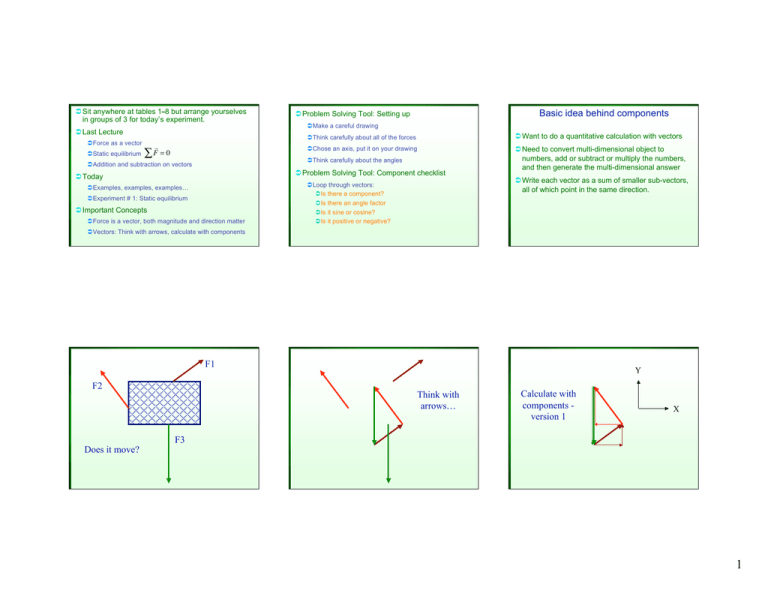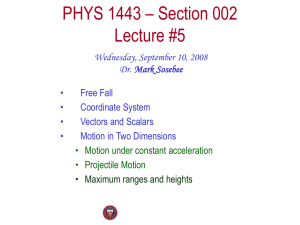Basic idea behind components
advertisement

Sit anywhere at tables 1−8 but arrange yourselves in groups of 3 for today’s experiment. Last Lecture Force as a vector ! Static equilibrium ! F = 0 Basic idea behind components Problem Solving Tool: Setting up Make a careful drawing Think carefully about all of the forces Want to do a quantitative calculation with vectors Chose an axis, put it on your drawing Need to convert multi-dimensional object to numbers, add or subtract or multiply the numbers, and then generate the multi-dimensional answer Think carefully about the angles Addition and subtraction on vectors Problem Solving Tool: Component checklist Today Examples, examples, examples… Experiment # 1: Static equilibrium Important Concepts Force is a vector, both magnitude and direction matter Loop through vectors: Is there a component? Is there an angle factor Is it sine or cosine? Is it positive or negative? Write each vector as a sum of smaller sub-vectors, all of which point in the same direction. Vectors: Think with arrows, calculate with components F1 F2 Does it move? Y Think with arrows… Calculate with components version 1 X F3 1 I: Given C, θ and φ=90o-θ Find A,B A Calculate with components version 1 φ θ Y B X C III: Given A, B, C Find θ, φ Y X Summary - II II: Given A, C, θ Find B, φ ! Fx = "A cos(# ) + Bsin($ ) = 0 ! Fy = Asin(# ) + B cos($ ) " C = 0 Experiment Advice - I Practice the component checklist and the guidelines for setting up static equilibrium problems. Don’t try to remember special cases, each problem is different! The units of force are Newtons. Make sure that the Force sensor is plugged into the 750 interface, the interface is plugged into the USB on the side of the monitor, and that the interface is turned on. Force of gravity on an object of mass M near the surface of the Earth is Mg where: g = 9.81 N One member of the group should log onto the computer to download the LabVIEW program to run the experiment. Some forces (for example, the normal force) will rarely be given but, instead, will usually be found using sums of forces. Don’t forget to use a section of L10 and decide around your table who will be groups A, B, and C. kg Summary - I Different ways of writing vectors are related by: F = F cos(! ) = F sin(" ) x F = F sin(! ) = F cos(" ) y F F = F 2 + F 2 tan(! ) = y F x y x F tan(" ) = x F y F φ Fy θ Fx ! ! Unit vector notation: F = F x̂ + F ŷ or F = F iˆ + F ĵ x y x y Experiment Advice - II Try to be as careful as possible about your measurements of the two distances. Check regularly that the weight hanger is in the middle of the string. It tends to move away from the center as you loosen the string. Notice that there are questions on both sides of the answer sheet. Each group should list all names on a single answer sheet turned in at the end. 2



